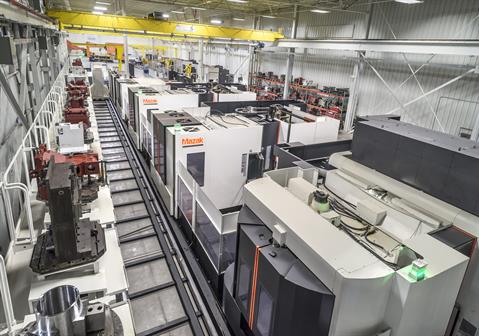Content from this blog was generated from a Viewpoint article on autobeatdaily.com.
The digitally connected factory is rapidly becoming a reality, thanks to huge leaps in affordable data handling capabilities. As more machines begin to communicate with each other, production efficiency goes up. Add the ability of analytic tools to predict maintenance needs, and productivity improves even more.
The components necessary to build truly connected “smart factories” are available today. The next step, according to Dan Janka, president of Mazak Corp., is to develop apps that can tap the vast database created by connected machines and deliver usable tools to move manufacturing productivity to the next level. Here he describes the promise and challenges ahead.

What does it take to create a connected factory?
For years such tools as ERP and MRP have been able to push information down to the production floor. But there wasn’t comparable flow in the other direction. Instead, you had industrial engineers with stop watches manually trying to maximize production efficiency and quality. You had armies of engineers looking for ways to be more productive.Now there’s Big Data. But it’s not helpful unless you can eliminate the digital “exhaust.” The next step will be to become predictive about manufacturing. We have the capability right now to measure just about every value in a machine tool: vibration, fluid viscosity, thermal levels, contamination, pH levels and more. This data can literally be streamed off the factory floor in real time. The challenge is to extract useful information from this huge information flow.
You can download an app for your smartphone for just about anything, but we’re not there yet in manufacturing. There are many products that monitor the factory floor and can tell you what happened yesterday or earlier today. The next frontier is developing algorithms that can detect patterns in the data. If you can predict, you can adjust and in some cases self-correct the system. At the least you can plan for downtime rather than scrapping parts.
When will we see the emergence of digitally connected factories?
It’s going to happen within the next five years. It’s more than changing the nature of manufacturing. It’s capturing knowledge about the process and creating cloud-based solutions that boost productivity and production quality to new levels.
This capability will be accompanied by a significant expansion in automation. The automotive sector has been a leader in this area for years, but now it’s accelerating rapidly across the entire manufacturing sector and deep into its supply base. We definitely see a trend toward re-shoring manufacturing from overseas. To be successful in doing so, we need to work smarter.
The good news is that it’s easier than ever to get started. The tools and technology exist today to begin at the machine level itself. Costs are coming down dramatically. We ship Mazak CNC machines today with a Smooth Monitor feature that can connect with the shop floor manager or owner’s smartphone via the internet. Similarly, it’s becoming very easy to teach and program a robot.
What about cyber security?
Productivity and security are different but linked issues. But digital factories aren’t going to become commonplace unless there is strong security to protect the data that flows to and from the factory floor. This is a growing concern in the supply chain, but the issue is being addressed very aggressively.What is Mazak’s role in the digitally connected factory?
We’ve been at the forefront of some of the world’s most advanced multi-tasking turning and milling machines since 1974. Our focus today is on four key areas that will define the factories of tomorrow. One is preparing for the digitally connected factory – something we’re doing in our own manufacturing facilities in Japan and Kentucky with the Mazak iSMART Factory concept. These facilities apply the MTConnect open communications protocol and process support software to provide connectivity and the capability to monitor and harvest data from factory floor machines, cells, devices and processes.
Mazak’s goal is to simplify automation with low-cost plug-and-play material handling as well as to offer solutions such as robots and multi-pallet pool systems that expand the concept of multi-tasking. The concept of multi-tasking involves machines that perform multiple operations – milling, turning and even additive part feature building – to complete parts in one machine setup. This is a more precise way of making parts than the traditional method of moving a part from one machine to another that requires refixturing at each step.
Lastly, we are strongly focused on the application of 3D printing/additive manufacturing. This technology is evolving very quickly. The engineering community is used to whittling away a piece of metal to form a part. 3D printing grows the part out of thin air. There’s a new set of manufacturing rules, and there’s endless opportunity for new applications. Our hybrid five-axis multitasking machines, for example, cut metal but also utilize a special cladding head that can add material to an existing substrate or component.
